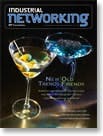College Drop-Out Hall of Fame
In his column, "Become Your Own Brand, March 07, Dan Hebert wrote, When I was a hiring manager, I saw resumés that indicated the job seeker had started a technical degree program but not finished his or her education.
I considered this a major red flag and tossed out the resumé. If someone couldnt complete an important task like finishing school, it was hard for me to see him or her sticking with a tough project.
Now, allow me to add a few possible punch lines:
and that man was Bill Gates.
and that man was Michael Dell.
and that man was Steve Jobs. FEEDBACK
Jerry Reilly, software engineer (andyou guessed itcollege drop out), Data Translation
Let us know what you think: FEEDBACK
PLC Portability
Jeremy Pollards column often is the most interesting feature. But I wonder if hes over-emphasizing PLC program portability. Im not as concerned with how portable a program is as I am with how well documented it is. As Pollard mentioned, even portable programs have some odds and ends to straighten out. Those loose ends can get really messy.
My experience is that succinct comments can make it an order of magnitude easier to maintain, modify, or rewrite a program. If I was in charge of a project involving the porting of some code, I would want to make sure that whatever comments the programmer created also were ported. If a program is uploaded out of a PLC and ported or converted, the comments that arent in the PLC might get lost in the shuffle.
I also think Pollard should explain why ladder is so pre-eminent. Having programmed in VBA a lot, I am a big-time fan of traditional computer language code. Some of my recent programs in ControlLogix have a third of the routines written in structured text. Its truly a godsend. But ladder is still the workhorse. For any kind of control, it provides unmatched tools for a programmer to write solid, stable, maintainable programs. Dont you agree?
Function block creates programs more like an electrical circuit than a traditional program. As function block programs get more complex, they become tough to understand and work on. Of course, for laying out a PID-based control strategy, function block is fantastic, as the process guys will strongly assert. Im sometimes one of them. Theyre correct, but I maintain that function block must be complimented by routines written in structured text and ladder that follow established, good-programming practices. Those routines contain all the rest of the code thats not best done in function block. Lets use the right tool at the right time. FEEDBACK
William Love, Kredit Automation & Controls, Phoenix.
Electives Would Be Piling On
Bob Martino, BSEE, PE, senior electrical engineer, Camp Dresser & McKee, Cambridge, Mass.
You Felt My Pain
I really liked your article on free electives for engineers. I was one of those 21-credit-hour-per-semester geeks. As such, there was no time for socialization like other students, much less an infrequent spectator at sporting events my school was well-known for.
However, an engineer always can, when given the chance, out figure the dominant Wall Street species. A little contrary to your premise, I would suggest continuing with additional schooling even with a full day-job to socially and professionally succeed.
Granted it is not immediate but not hopeless. A more rounded education I agree is much better. FEEDBACK
Leonard Walsh, Engineering Fellow, Pratt and Whitney, E. Hartford, Conn.
Keep Your Eye on the Prize, Please
I totally disagree with the concept of less math and more socialization. Public safety is important issue. Buildings, bridges and processes need engineers who know how to do the math, otherwise things might come crashing down or blowup. These are the things engineers build, and universities and engineering colleges should be educating people to engineer them to last and keep people free of system failures. These schools should not provide platforms for drunken binges and sex parties. That should be left to the liberal arts schools. FEEDBACK
Joe Vallone, Phelps Dodge, Phoenix
Never Needed All the Math
I fully agree with Dan. When I was an electrical engineering student at the University of Kansas in the 60s, I was required to take 21 hours of math beyond college algebra. I have been employed as an engineer for nearly 40 years in electronic circuit design, utility power engineering, and as a facilities engineer, and I have never used any math beyond algebra and trigonometry.
My career has been strongly influenced by being one of the few engineers who developed good communication skills. So many engineers cannot communicate effectively in oral presentations or in writing, and it severely limits their career opportunities.
When I graduated in 1968, one of my friends interviewed with Collins Radio Co. They gave him a test. The interviewer asked him if he could write down Maxwell's equations. The applicant responded, "No. Can you?" The interviewer said, "Fair enough. Let's move on to the next question!" FEEDBACK
James Cook, PE, RCDD, Staff Consulting Electrical Engineer, Hallmark Corp., Kansas City, Mo.
We Are Not Alone
My best friend is a ChE major and I forwarded Dans education column on to her. She was grateful to find someone with experience, who was not advocating more and more relentlessly challenging homework assignments. She said she and her peers in class talk about the unbalanced education they are receiving. This is a really bright girl, but a few months ago I shared with her the concept of time value of money I learned from a basic finance class, in the context of buying a car. The concepts made sense to her mathematical mind, but she had never been taught the simple life-skills knowledge because she was never allowed to take a finance class.
She said the Engineering adults the students are around -- Deans, professors and TAs -- all fall under the more engineering classes = better engineers mentality. Therefore, even though the students think their division of classes is quite unbalanced, the trusted professors lead them on that eight to 10 really hard problems every night for four years will make the students better engineers. She very much appreciated hearing from someone out in the working world that there is more to life than algorithms. FEEDBACK
Morgan McCarty, media relations coordinator, National Instruments, Austin, Texas
A Toast to Social Skills
I support everything Dan said about engineers and people skills. Along with people skills, I've noticed engineers also have difficulty communicating with non-technical people about what they do. I am an engineer and discovered an effective avenue to improve ones communication and leadership skills is Toastmasters International. This 210,000 member, non-profit organization does wonders to improve people skills and I highly recommend all university students join a club near their campus or, better yet, form a club on campus.
When I tell people that I am an engineer they appear very surprised, as I do not fit into the conventional stereotype of a geek. The skills I've gained through Toastmasters has helped me enormously in my career as well as in my social life.
Thanks so much for emphasizing the importance of social skills of being an effective engineer. If you have any interesting stories involving engineers who are people skilled challenged as well as engineers who have great people skills I would be thrilled if you could share them with me. FEEDBACK
Edwin Bernard, Industrial Electronic Engineers, Van Nuys, Calif.
[Dan says: My wife says I am pretty social "for an engineer." Of course, she has a Masters in Computer Science, so this might be low praise.]
Bad PLC Book, Good PLC Book?
Rick Minch, BETech Inc., Fletcher, N.C.
[Jeremy responds:
Youre right, Rick. Check out this months column, "Back to the Books: PLC Easy Reader." I think it will close the loop for you.]
Those Social Engineers
Thank you for giving voice to a better vision for an engineering school [Less Math = Better Engineers, Nov06]. Dan Heberts article brought back memories of discussions I had with two of my friends in engineering school (working problems late at night out of Streetmans solid-state book) concerning the lack of balance in engineering education. Little did I know at the time that one day I would have the opportunity to lead the EE accreditation efforts of a small liberal arts engineering program, and start a school of engineering from scratch.
Someone has and is doing a lot of what you are saying. At my former school the result was employers waiting in line for our graduates. One even left the business he founded and started another one two blocks away from my former school, so he could have access to our engineers.
I spent a lot of time thinking about and listening to industry feedback about what skills really are needed for engineering graduates. One example was the need for more project management skills. I hired a former Boeing project manager and implemented a system in which our students would interact and cross train business students taking operations management during their junior year.
At the end of the year each group had to the other groups presentation. The engineers complained loudly at the time, saying they dont think like us, they dont get it, I just want to build stuff. The first thing I did as dean was take my new boss to visit companies that had hired students from my former program. To a person the students (now alumni) said that was one of the most important and relevant parts of our program.
Just as you said, the soft skill set development does not have to take away from technical competence. At my previous school, I required all students to take and pass the online practice EIT exam. The first year our students scored an average of 34% points above the national average in the PM or EE portion of the test the first time they took it. On ethics, it was 92% compared with 59% nationally, and in a general section in which EEs are tested in areas they did not study, such as fluid mechanics, material science, statistics, etc., they scored considerably above the national average in all but one area. You get the idea.
If you know of any good people in this area to bring on board an exciting new startup of an excellent engineering program let me know. I only wish you were closer to southern California so that it would be convenient for you to serve on our engineering advisory council. FEEDBACK
Anthony L Donaldson, Dean of the School of Engineering, California Baptist University, Riverside Calif.
[Dan replies:
Good news! I actually do live in SoCal, Irvine to be exact. I would very much like to meet with you about the subject.]
Weve Kicked the Ladder Logic Habit
I found some of what Jeremy said about IEC 61131 [Slow Going for IEC 61131, Sep06] pretty interesting.
When people see the advantages of using the right program language for the task, then IEC-61131 will take off. One of the advantages we see is the ability to easily translate a program from one platform to another depending on what the customer wants. This is much easier than translating from, say, an old A-B PLC-5 to a Modicon 984.
We build systems on several different hardware platforms. They all use the IEC-61131 programming language. I thought it was interesting that you find most North Americans use ladder logic. I was never as happy as the day I was first exposed to an IEC 61131 programming environment--a pre-release version of Triconex Tristation 1131, and realized I would soon never have to do relay ladder logic again.
The last program I did had only one small custom function block made with ladder logic because it was simple to do and understand in ladder. The meat of my program was done in structured text inside function blocks and linking everything together was done in function blocks. Most of our programmers here use primarily function blocks with very little if any ladder logic and some of the custom function blocks contain structured text. FEEDBACK
Larry Richardson, Sr. Technical Specialist, UOP Equipment and Systems, Des Plaines, Ill.
[Jeremy says:
Im guessing youre a process guy. Most have no issue with IEC-based programming since it is something they are comfy with. Most machine builder type guys are not, thus the survey said they use ladder. Since ST is the only language that can be portable, the movement to alternate hardware platforms can be fast and easy as far as the source code goes. You need to re-create the tags and FB structure but the code behind them is already done. Very cool and functional for process and since customers can see FB, it is of no consequence for them. Discrete guys are not of the same cloth.]
Let's Promote the Value of Well-Rounded Engineers
I couldnt agree more with Dans article on engineering and the social aspect of the work place and education ["Less Math = Better Engineers," Nov06]. I thought you delicately and precisely narrowed in on where our engineering education falls short. I myself have a degree in Mechanical Engineering and I found similar experiences in college, staying up way too late to work on problems at the expense of other parts of my life. But more importantly, I like how you emphasized the fact that firms and companies today do not look for excessive engineering skills, but good teambuilding and communication skills. Id like to know if there is any other literature, or perhaps an organization I can join to promote this cause (if there is one I suppose). FEEDBACK
Kevin Murray, manufacturing engineer, Genie Industries, Redmond, Wash.
Don't Overdue the Electives Stuff
I agree that people skills are a very useful attribute for most people working in industry today. I can't agree that engineering schools should load up their students with more non-tech electives in place of tech courses. I have watched my son at Ohio State for the past four years. He will graduate this year with a BSME and a business minor. He really does not have time or inclination to take more electives. I think either you like to work with people or you don't. If you do, you will learn how to do it and if you don't, you won't. Let them get out a little while to see what they like FEEDBACK
D. Laing, Hellan Strainer Co., Cleveland
The Engineer's Soap Box
I could not agree more. Your message should become a mantra! I like particularly the statement: "Engineers are hired because their degree shows that they have a high level of intelligence, enormous self-discipline, and a strong work ethic." It is worth repeating again and again in many media venues. Since you appear to have a public forum, might I encourage you to go for it. FEEDBACK
Alfred Weisbrich, PE, president, Eneco Texas, West Simsbury, Conn.
Sill Inaccurate About NEC
This is in response to the letter published in the October Feedback section, NEC and UL Are Different. In his response, Ed Brindza provides inaccurate information. The NEC is not a governmental agency involved with licensing the installation of electrical devices.
The NEC, NFPA 70, is a safety code published by the National Fire Protection Agency (NFPA), a nonprofit organization. This information is stated clearly on their web site. The NEC does not vary based on geography. What might vary is which code cycle, if any, has been adopted and whether or not parts have been excluded. I question the accuracy of his blanket statement that the NEC guidelines are not recognized by insurance companies. The insurance underwriter for my employer requires that all electrical work, from new construction to improvements must be done in accordance with the NEC in addition to local code requirements.
Also, the NEC is recognized by all municipalities in which it has been adopted, evidenced by the required inspections all residential, commercial, and industrial buildings must pass. Using the example provided by Mr. Brindza of a plant installation with explosive materials, the NEC provides the guidelines under which the components are to be installed. I would hope in the event of a failure, the insurance carrier is going to look beyond a device being UL and confirm it was installed in accordance to the approval and the requirements for the area. I do agree with Mr. Brindza that someone publishing and operating in and electrical environment should be more knowledgeable. To allow a letter with this level of inaccuracies to be published is a severe oversight. FEEDBACK
Tony Acri, assistant project manager, product engineering, Baltimore Aircoil Co., Jessup, Md.
Credit Where Credit Isn't Due
I have some concerns about Control Designs Readers Choice Awards concerning the reflected brand identification/loyalty for some companies that score well in a category, even though they dont even have a product in that segment. My intention isnt to take shots at Rockwell, but, as a giant in our North American market, its natural that many of its customers are seeing Rockwell as a brand reflected onto other products. However, we dont need to help them gain more identity where it doesnt exist. Either that or many readers are interpreting the categories in a biased way. Some examples of this phenomenon include:
- Controller, CNC: 13% vote share, but Rockwell hasnt made a CNC since the late 1990s as far as I know.
- Controller, Motion: 41% vote share. This appears to be based on the fact that the ControlLogix PLC can handle motion, but is that a true motion controller compared to Galil and others that make dedicated motion controllers?
- Data Acquisition System: 25% vote share. Again, it looks like a PLC-based reader votes for Rockwell because it can handle some DAQ functions. Was that the real product category, or is it for dedicated DAQ systems?
- Motor, Stepper: 21% vote share. They have stepper controllers, but I dont know of a Rockwell stepper motor. Your photo insert was even of a stepper card.
- Single-Board Computer: 18% vote share. Rockwell doesnt sell SBCs; it sells IPCs. Showing a photo of an AB Pico controller was beyond the pale as this is basically a smart relay.
- Software for DAQ and CNC are similar comments. Rockwell does not have such products as far as I know.
- Software for PC-Based Machine Control: 29% vote. Photo is RSLogix 5000, which is for the ControlLogix PLC. Their Soft PLC is SoftLogix, which they dont really promote.
To me, the market dominance of Rockwells ControlLogix PLC clearly has been reflected into categories where they dont deserve to be. Im not sure how your survey can be made to screen some of this interpretation/bias out, as it is does bias the votes, but at least you can think about it.
Graham Harris, President, Beckhoff Automation, Burnsville, Minn.
[Editors reply: Graham makes many good points. Our Readers Choice awards are deliberately unstructured in order to give full control of the process to the technology users/specifiers. It likely means that some voters will endorse legacy products that are working well for them in the field, whether or not the manufacturer has since discontinued their manufacture. A robust used-parts market makes that possible in many areas of Machine Builder Nation. Its also true that some technology users are building applications, quite successfully, around products that have a different primary function. Graham points out several of those applications. In all these cases, however, as far as we can tell, its an accurate reflection of what responding users say works for them. It seems that we should include them in the results. Were always open to suggestions about fine tuning our content. If any current or future Readers Choice voter has some ideas about tweaking the process, we want to hear from you.]
Joe Feeley, Editor in Chief
Good Safety Assessment
As a member of the Board of Directors of AS-Interface/USA, I need to point out that the "tools issue" you mentioned has been fully addressed by AS-Interface Safety at Work. A joint, educational article for Industrial Networking, talking about how the existing tools aide during the commissioning and troubleshooting phase of a safety project using AS-Interface Safety at Work, would be of great interest to me. FEEDBACK
Helge Hornis, Manager Intelligent Systems Group, Pepperl+Fuchs, Twinsburg, Ohio
Readers Choice Voters Got It Wrong
I was chagrined by the results of your 2005 Readers Choice service and support leaders survey [Black-Tie Technology, Nov. 05]. I have programmed just about every PLC family ever made, using both manufacturers and third-party software, from the incredibly difficult Omron Sysmac software for DOS in the early 80s to the latest Siemens S7 and Rockwell Automation ControlLogix software. In fact, I started in 1977, programming 5TI controllers with a handheld Boolean programmer and 084 Modicons, using a push-button programmer.
I am amazed that your readers classified Siemens PLC programming software 0.3 at a grade higher than Rockwell Automations product. Indeed, the folks who voted this way must not be familiar with Rockwells product. While Siemens PLC hardware is completely reliable and more economical than Rockwells software, Siemens software is an experience in aggravation every time I have to use it. Can you drag any elements around into position on the ladder programming screen in Siemens software? Can you work with the annotation for the whole program in the tag editor? You cant. All annotation for all data file elements is in the individual data files only. Before version 5.2, Siemens still hadnt caught on to the fact that ladder logic users need the annotation right over the top of each of the ladder elements, and not in a general listing at the bottom of the rung.
Here is (part of) a message I received last year from a fellow controls engineer from the U.K. that I met in India in 2000: I had an RSLogix5K job to do in Indonesia at the beginning part of this year. What an absolute joy! Combined with RSView, it was a complete holiday. There is no way anyone needs to take a training course for this stuff. If they do, they really shouldnt touch PLCs. I also had the pleasure of going back to a job that I did in 2000 for them (which was one of the first), and extended the machine by 10 motors and three loops. I wrote the lot on site in a morning, including tidying up the HMI. I had a similar job to do with S7, and it took me two and a half days. Okay, it worked just fine, but I was no where near so confident as I was with Logix 500.
Actually, the PLC programming standard that all PLC software packages aspire to, but still fall short of, is the old DOS-based Icom software developed for Allen-Bradley PLCs in the late 80s and early 90s, specifically their AI Series. When Rockwell finally took them over, they based their RSLogix family of software on it, but never quite finished the job. They still failed to match the incredible search window of the Icom software.
I challenge anyone who voted in favor of Siemens PLC software to actually try Rockwells software (any family of PLC will do). By the way, AutomationDirect deserves the top billing they achieved for PLC programming software, except their PLCs still arent tops in the mainstream of industrial control. FEEDBACK
Stephen H. Jones, chief electrical engineer, Menzel/Fishburne, Spartanburg, S.C.
[Editors note: It might help the discussion to clarify the published results. Jones is referring to the Service and Support scores these companies received in the PLC Programming Software category. Siemens scored 4.4; Rockwell Automation scored 4.1, and AutomationDirect scored 4.5. This is based on a scale of 1-5, with 4 considered very good and 5 considered excellent. These scores are based on the respondents rating of the companies service and support capabilities and, while likely interconnected, dont necessarily relate to an evaluation of actual product performance.
In the product categories, we asked respondents to name the company that provided the best technology value. For PLC Programming Software, 66% the respondents chose Rockwell Automation, 10% named Siemens, and 9% selected AutomationDirect.
Wed welcome reaction to Jones observations and further responses to the surveys results.] FEEDBACK
Think Trouble
Diagnostics is so important, and yet most programmers think the world is an ideal place. Throughout my career, I have yelled at several programmers when Ive heard them use the expression, "That should never happen.
I also want to add that, when youre troubleshooting, take the approach of "starting at the plug and work your way in." Too often, troubleshooters delve too deeply into a system, and miss the obvious. FEEDBACK
Lawrence Gabriel, electrical engineering coordinator, W&H Systems, Carlstadt, N.J.
Standards: A Necessary Pain
However, many standards (guidelines) are worded so poorly that if you had 10 inspectors read a standard and apply their understanding, you could end up with 10 results. Many companies (including us) contract third-party inspection houses to complete inspections, and certify adherence to standards that include UL, CSA and NFPA. And with the constantly growing CE requirements of the European community, any company can only hope that its keeping up. Sometimes you learn about requirements only when you have been "challenged" on a given standard. Sometimes these challenges come from an inspector for a specific company, and often is a new interpretation of the standard. But well do whats necessary to conform because its "cheaper" ultimately. Customers and/or their representatives are always right, especially if you want repeat business. FEEDBACK
Richard Buchanan, electrical design and retrofit supervisor, Giddings & Lewis Machine Tools LLC, Fond du Lac, Wis.
Its Fun Looking Back
I ENJOYED your HMI article [Our HMI Heroes, Embedded Intelligence, Nov. 05]. Yes, I remember the T-1, T-2, T-3 and the Modicon P190 and TI VPU. Who needed weight training? You also may remember one of the first leaders in the move to personal computer programmers. Was it Osborne w/CPM and Zorba w/DOS 1.0? What about the Universal Programmer/Documenter, UP/DOC, by Xcel Controls in Mishawaka, Ind.? I even integrated it to AutoCAD (DOS also) for I/O drawings. It was cool stuff "back then."
I worked and reped for them for several years, and had a good time demonstrating the product "live." The best way was to go to the plant, walk out on the floor, download the program, then go back to their office, and show them how it works with their own programno canned stuff. Speed of cross referencing was an issue then and the UP/DOC program was fast.
They also were great people to work with. However, they never moved on the PLC 5 product, and I moved on. FEEDBACK
Jim Robinson, CCST III, M.G. Newell Corp., Greensboro, N.C.
Standards Are Good
THE OPEN standard vs. proprietary control architecture discussion [A Standard Reaction, Nov.05] needs to be placed in todays context of moving away from islands of automation to connected factories. When the focus was just on automating a machine to reduce costs, a proprietary system was acceptable because most end users had a staff of control engineers, who could be trained to maintain that unique system. Also, production runs were long with few changes in the end product.
However, global cost pressures and the need to innovate have caused many companies to move toward production in smaller batches, as well as use more flexible manufacturing lines that can build a variety of products. Theyve also had overall reductions in manpower to cut costs. This means controls must be able to handle more motion to meet demand for flexibility, and add connectivity to MES and ERP systems. Most companies have to manage these changes with fewer technical people, smaller training budgets, and less time to do it all. Innovative companies looked at standards to help them handle this transition, including:
-
Open standards for sensor and actuator networks, such as Profibus, DeviceNet and Modbus
-
Ethernet-based protocols for control-to-control, control-to-ERP and control-to-MES systems
At the same time, some machine builders looked at the real cost of automation, realized that engineering time was becoming their largest cost, and knew they needed a better approach to rein in this growing element.
One engineer I know says, Software defines. Hardware implements. This issue has led many companies to move to an open programming tool called IEC 61131-3, which is supported by the PLCopen organization. IEC 61131-3 gives programmers plenty of flexibility because it includes five different programming techniques, and doesnt force them to use one approach to handle all control needs.
As the need for integrated motion has increased, another standard has improved productivity. This is the PLCopen motion block, which allows motion to be a fully integrated part of the sequencing program.
At Beckhoff, we also view the PC itself as another open standard for automation because its the most common automation hardware design in the world. An industrial PC or embedded PC with a Microsoft OS, an Intel processor and integrated Ethernet ports running an IEC 61131-3 real-time control system is todays most powerful, flexible, cost-effective, open control system. We believe the next step will be to use a common Ethernet protocol at both the I/O and motion network levels.
In addition, the EtherCAT specification was submitted to IEC in November 2004, and passed with an overwhelming majority. Since EtherCAT was written with IEC standardization in mind, seamless integration into the next edition of the fieldbus IEC 61158 is expected. This is not a 75% solution but a +100% solution to most companies.
Yes, you will find special proprietary designs for very special applications, but they are decreasing in number every year. FEEDBACK
Graham Harris, President, Beckhoff Automation, Minneapolis
Survey Should Say:
Remote Monitoring is Doable
I WAS pleased to review the results of your recent web survey on remote monitoring [Remote Diagnostics and Troubleshooting, Nov.05]. Your results are not surprising. They reflect an emerging knowledge, hence, experience by both practitioners and end users with current remote control offerings.
Lets fast forward to the state of the art in remote control, which addresses security, cost, and ease of use issues raised by survey respondents. Its quite feasible these days to use a mobile thin client and managed service to remotely operate factory-floor applications, data and network resources. Users dont carry any applications and data in this model. And the solution can be made to work seamlessly over any network connection to the Internet, including WiFi, cellular data, Ethernet or dial up.
Since systems behind firewalls have to initiate connections, requiring devices and users to be authenticated, the usual concerns about firewalls can be eliminated. Threats, such as viruses, malware, man-in-the-middle attacks and many others associated with browser-based services could also be mitigated. IT administrators have long understood the value of remote control to provide remote help desk services in the office. FEEDBACK
Josef Zankowicz, marketing and communications VP, Route1 Inc.
Standards Offer Legal Protection
THE STANDARDS that we all worry about, which are getting increasingly vague, are the result of a need to "distancing oneself from lawsuits." If I build a control or incorporate a control into my machine, then Im legally committed in a lawsuit, if injury or adverse action happens. If the control meets certain standards, then we automatically have a defensible position to start from. There is no other reason to have what I would describe as generic control or control software. FEEDBACK
Ed Zidek, press brakes product manager, MC Machinery Systems Inc., a Mitsubishi company, Wood Dale, Ill.
Dont Whack the Programmers
Shared PLC Pain
Marlin Hostvet, electrical designer, Oxbo International Corp., Clear Lake, Wis.
Death of NMW Greatly Exaggerated
Kelvin Marsden-Kish, Industry Vice President, Reed Exhibitions, Norwalk, Conn.
You Must Protect Yourself
As an intellectual property attorney and president of Wisconsin Advanced Technology Advocates, I try my hardest to make sure that inventors and innovative businesses are rewarded for their important contributions to our world. Your article [Protect Your Intellectual Property, Mar. 05] offers great practical advice to those in your industry who work hard to create technological advantages.
Often the best approach to protecting innovation rests in the sorts of practical steps you describe. I cannot tell you how many times my clients seem shocked when I ask them what they can do to protect their intellectual property. Obviously, it is my job to secure and protect their rights, but enforcing those rights is expensive.
If a competitor is undercutting you with your own invention, you have immediate financial issues that litigation costs will not help. Software and coding are the most susceptible to misappropriation since most of the costs are incurred in development. Although manufacturing costs may make it more costly to steal other innovations, given off-shore labor costs and the blind-eye many nations turn toward intellectual property rights, no industry is immune from this problem. FEEDBACK
James B. Gehrke, Gehrke & Associates, Wauwatosa, Wis.
The Anti-Apprentice
YOUR EDITORIAL [So Hire an Apprentice, Mar. 05] hit a nerve with me. Didn't we used to have apprenticeships for most jobs in the past? From what I have read, they worked well. I suggest to you that we not only don't have the apprenticeship programs as you say, but it goes further; we actually have the equivalent of anti-apprenticeships going on today!
You are correct, of course, that there are heavy behind the scenes costs associated with employees. As a small company with less than 10 employees, in order to put significant retirement money away, we must put the same percentage in all employee's retirement account each year. The maximum allowed by law in our program is 25% of W-2; so if you add this in with your $10,000 additional overhead, it is more like $ 20,000 or $ 25,000.
In my opinion our colleges and universities do this country a large disservice by instructing graduates on what starting pay to expect and demand. They have the starting pay for engineers at levels that are higher than what many seasoned, experienced engineers earn after years of working. I believe these inflated pay levels cause large corporations, which need new recruits, to be bullied into paying higher rates each year. The result today is similar to the stock market of a couple years ago--the rates are out of hand. Hence my anti-apprentiship comment. Rather than paying a lesser amount to an inexperienced new employee and helping them learn the trade and become experienced and having their pay rise accordingly. I have been told by recruiters that cost of living differences in different parts of the country is taken into account. While Im interviewing new recruits, I see they believe what they are told. If one goes to their favorite search engine and looks up salary calculator, or cost of living by city, they will see examples such as $ 50,000 in Chicago is equivalent to $ 23,089 in Dayton, Ohio. But the recent college grads are being told that this is not an issue, that they should expect the same $50,000.00 salary in Dayton. This is a disservice to this country.
I suggest this is a trend that is helping drive jobs and manufacturing offshore. I call this worse than no apprentiship. FEEDBACK
Mike Kilroy, CMCS, Mike Kilroy Corp., Farmersville, Ohio

Leaders relevant to this article:














